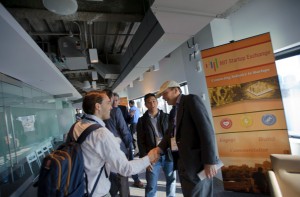Alumnus Makes Connections with Content, Corporations
-
-
slice.mit.edu
Filed Under
Recommended
To bring this idea to fruition, Manandhar left London in 2002 and moved back to Cambridge to tap his MIT connections. “I attended a demo at the Media Lab and started talking with the student leading it,” he says. Manandhar gave that student, David Crow ’03, his business card. Months later, Crow became employee number one when Manandhar launched Aerva, a service that enables real-time interactivity between digital displays and content managers, allowing users to manage digital displays remotely with just a browser.

That means that that huge digital display you see in Times Square could be managed by someone on their smartphone, thousands of miles away. Aerva serves clients as big as Anheuser-Busch—helping the company manage interactive displays on their coolers—to small companies like ImprovBoston, which uses Aerva to manage just one display in their foyer.
After ten years of business, Manandhar recently decided to sell Aerva. That’s when he was connected with MIT’s Industrial Liaison Program (ILP), which helps to create relationships between MIT and corporations, and the Startup Exchange (STEX)--an initiative of ILP--which connects these corporations to startups. “I always knew about ILP while I was at MIT, but figured it was just for big companies, not for startups like us,” Manandhar says. Working with ILP and STEX, Manandhar made connections and gained knowledge on the process of finding a buyer for Aerva. “It’s a great opportunity. I metwith companies I never would have connected with otherwise,” he says. Manandhar began talks with companies that he met through a STEX event, but ultimately decided to sell to a different company. Manandhar says that STEX is beneficial to Aerva as the company continues to operate independently despite acquisition. “It’s important to understand how these other companies work,” he says.

STEX lead Trond Undheim says insight and connections are what STEX strives for. “We have over 200 large member companies that are interested in startups—STEX is a vehicle for those companies to connect,” Undheim explains. This is done through events and opportunities where member companies can outline the type of startup they’re looking to work with. Undheim says that the ILP has been facilitating these kinds of relationship for 67 years while the newly-launched STEX is helping to make the process even easier for startups. The easiest way for alumni to begin taking advantage of STEX? Add your company to their database of over 1,100 MIT affiliated startups.







